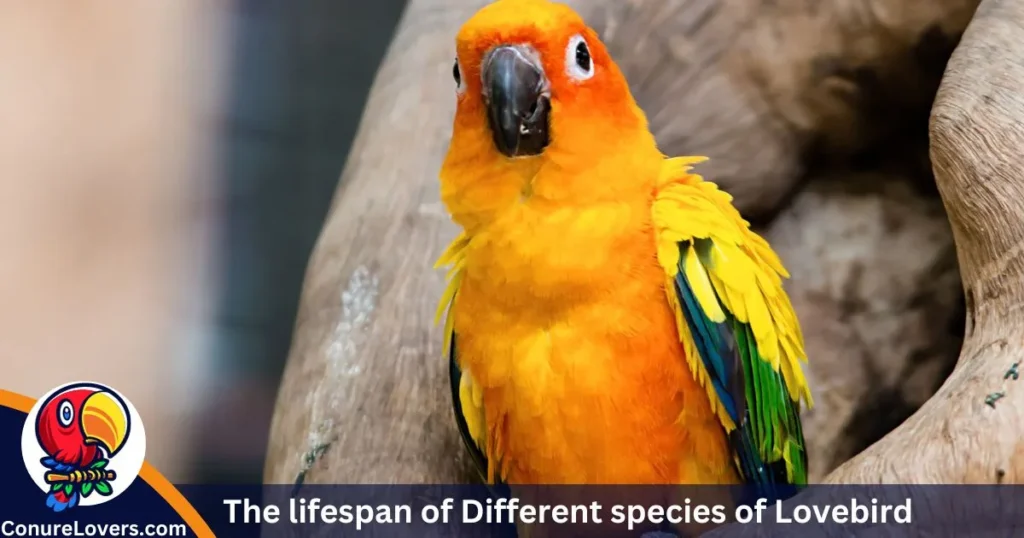I found two lovebirds in a sunny forest, singing happily and snuggling together. It made me wonder, “How long do lovebirds live?” So, I observed them to learn about their lifespan.
Those love birds showed that love can last a long time, even for feathered friends. In this article, we’ll explore the world of lovebirds and how long they live. We’ll talk about what affects their lifespan, the different stages of their lives, and the joys and challenges of caring for these cute pets as they grow older.
Whether you’re a pro at keeping lovebirds or just think they’re adorable, let’s uncover the secrets of their lifespan and understand their loving nature.
Lots of things can make wild lovebirds live shorter lives, like not enough food or water, strange weather, and predators. Wild lovebirds usually live around 5 to 15 years. But if you take good care of lovebirds kept as pets, they can live longer, between 10 and 20 years.
| The Lifespan of Different Lovebird Species | |
| Specie Name | Lifespan |
| Rosy-Faced Lovebird | 15-25 Years |
| Fischer Lovebird | Up to 20 Years |
| Black-Winged Lovebird | 15 Years |
| Black-Collared Lovebird | 10-15 Years |
| Lilian’s Lovebird | 15-20 Years |
| Masked Lovebird | 10-20 Years |
| Red-faced Lovebird | 15-20 Years |
Lovebirds Lifespan in the Wild
Let’s talk about how long wild lovebirds live. We don’t know a lot about their lifespans in the wild. Wild lovebirds have a tougher life than those kept as pets. In Africa, many baby lovebirds might not make it to grow up.
If everything is okay, wild lovebirds can live for 5-15 years, says WebMD. How long they live depends on having enough food, no predators around, and access to water.
Lovebird’s Lifespan as Pets
A pet lovebird often lives longer than its wild counterpart. However, pet lovebirds can’t control the availability of fresh food, supplies, and proactive veterinary care, crucial aspects of nursing care.
Each of these factors has the potential to directly influence lifespan. With proper care, your pet lovebird can live for 10-20 years, as noted by WebMD. Lovebirds are highly sensitive to isolation.
Because they bond for life, these little birds are known as life-bonding parrots. For a lovebird to be happy and healthy in captivity, they need a companion from the same species.
The lifespan of Different species of Lovebird

Different African lovebird species have varying lifespans. All pet lovebirds belong to one of the nine species listed here, showcasing an impressive array of colors and patterns.
Among the most popular pet lovebirds are Fischer’s lovebirds, peach-faced lovebirds, and black-masked lovebirds. Each of the nine African lovebird species has a distinct expected lifespan, detailed below.
Black-cheeked Lovebird:
The black-cheeked lovebird, Agapornis nigrigenis, faces habitat loss in southern Zambia. In captivity, they can live up to 13.75 years.
Black-collared Lovebird:
Also known as Swindern’s lovebird, Agapornis swindernianus, this species has a life expectancy of about 10 to 15 years in captivity.
Black-winged Lovebird:
Agapornis taranta, or the Abyssinian lovebird, known for its black wings and red throat, lives an average of 15.83 years in captivity.
Grey-headed Lovebird:
Found on the island of Madagascar, the grey-headed lovebird or Agapornis cana, also known as the Madagascar lovebird, has an average lifespan of 16.01 years in captivity.
Read Also: Can Sun Conures Eat Cherries | Good or Bad for Them? (2024)
The lifespan of Fischer’s lovebird
In captivity, Fischer’s lovebirds can live up to 20 years and are renowned for being one of the gentlest species. Surprisingly, a Fischer’s lovebird has been known to live for an impressive 32.24 years when kept captive!
Peach-faced Lovebird:
Peach-faced lovebirds boast a lifespan of 15 to 25 years in captivity and are sometimes referred to as Rosy-faced lovebirds. One of the oldest recorded lovebirds lived to be an astonishing 34.34 years old.
Masked Lovebird:
Yellow-collared lovebirds, also known as masked lovebirds or Agapornis personatus, can thrive for 10 to 20 years in captivity. The oldest recorded masked lovebird reached an impressive age of 24.24 years!
Red-faced Lovebird:
In a historical study of parrot survival in captivity, the red-faced lovebird, or Agapornis pullarius, was documented with a maximum lifespan of 19.23 years.
Lilian’s Lovebird:
Lilian’s lovebird, also known as the Nyasa lovebird, typically has an average lifespan of 10 to 12 years. Remarkably, those in captivity have thrived for an average of 19.2 years!
To Lengthen Your Lovebird’s Life:
1. Healthy Diet:
Offer a well-balanced pellet-based diet, including a variety of fruits and vegetables.
2. Regular Exercise:
Make daily exercise a routine to keep your lovebird active and healthy.
3. Social Interaction:
Ensure daily social interaction to keep your lovebird engaged and happy.
4. Avoid Loneliness:
Avoid leaving your lovebirds alone for extended periods to prevent loneliness.
5. Companion Support:
If you lack interaction time, consider providing a companion for your lovebird.
6. Spacious Living:
Give them a large cage with toys and perches for mental stimulation and physical activity.
7. Veterinary Care:
Schedule regular vet visits to monitor their health and catch any issues early.
8. Vaccination:
Consider getting your parrot vaccinated for added protection against potential illnesses.
Factors That Affect a Lovebird’s Lifespan
A lovebird’s lifespan can be influenced by various factors, and providing proper care is key to ensuring a long and healthy life. In contrast, wild lovebirds might experience a shorter lifespan if not cared for properly.
Factors Affecting Lifespan:
1. Diet:
A well-balanced diet is crucial for a lovebird’s health, similar to any pet or human. Unfortunately, some lovebird owners may not be aware of the proper foods to feed them.
2. Environment:
The surroundings and living conditions significantly impact a lovebird’s lifespan. Creating a safe and comfortable environment is essential.
3. Exercise:
Regular exercise is vital for maintaining a lovebird’s physical health. Ensure they have opportunities for play and movement.
4. Medical Care:

Providing proper medical care, including regular check-ups, contributes to a lovebird’s overall well-being.
5. Companionship:
Lovebirds thrive on social interaction. Having companions, whether bird or human, positively affects their lifespan.
6. Neglect:
Neglect can be detrimental to a lovebird’s health and lifespan. Regular attention and care are crucial.
Dietary Importance:
A proper diet is fundamental to your lovebird’s health, mirroring the significance of nutrition for any pet or human. Unfortunately, some lovebird owners may lack awareness regarding the appropriate foods for their feathery friends.
Lifecycle of lovebirds
Within a week of mating, a pair of nesting lovebirds typically lay four to six eggs. Once laid, the female takes on the responsibility of incubating these eggs for approximately 21 to 23 days.
It takes about 43 days for young lovebirds to fledge, meaning they can leave the nest, but they continue to receive care from their parents for an additional two weeks. During this time, their feathers become more vibrant, and they experience their first molt at around five months of age.
Lovebirds reach sexual maturity at around 10 months old. After approximately a year and a half, many of these parrots engage in breeding for the first time, forming strong monogamous bonds with their mates.
Does a Lovebird Live Alone for Long?
Lovebirds are usually kept in pairs because they are very social. They enjoy being around other lovebirds, although it depends on the specific type of lovebird. Some different kinds of lovebirds can get along.
However, it’s essential to know that keeping them together doesn’t mean they have to be in pairs. If you have the time and energy, you can spend time with them and give them the social interaction they need. But many pet owners find it hard to meet these needs, and it’s not good to leave them alone all day.
When lovebirds feel sad or lonely, they might do things like plucking their feathers, which is not good for their health and can affect how long they live.
If you have a job or other things to do all day, it might be tough to give your lovebirds the company they need. In such cases, having another bird as a companion is often the best solution.
Conclusion
Choosing a lovebird as a pet is a fantastic idea for several reasons. One significant advantage is their long life expectancy, and they can comfortably live in captivity for 15 to 20 years. Some species can even surpass this range.
Ensuring your lovebird’s well-being involves providing a healthy diet, opportunities for exercise, a suitable living environment, and companionship. Owners have control over many aspects of their bird’s care, but there are also factors beyond their control.
On average, birds are expected to live for 10 to 20 years, with some exceptions reaching up to 40 years. It’s crucial to plan accordingly for the care and commitment your feathered friend will need over its potentially long and happy life.

Nicholas Clark here, your Easy Conure Care Guide at “Conure Lovers.” I’m here to simplify conure care for you. Let’s navigate the basics together, ensuring your feathery friend enjoys a colorful and chirpy life.












